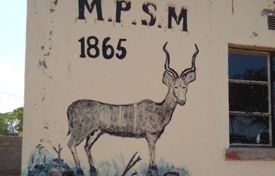Baherero culture kept alive through Otjiserandu
MPHO TLALE
Staff Writer
| Friday April 5, 2013 00:00


Commemorated every year on the 26th of August, the day is of great historical significance to the Herero people as they continue it as a tradition used to honour the memory and homecoming of the late Samuel Maherero as well as other fallen Ovahehereo leaders.
The late Samuel Mahereo was the chief of Baherero who brought them to Botswana around 1904 as they fled from the marauding German colonists in the then South West Africa, now Namibia. After his death and burial, his body was exhumed in 1923 after he was buried in Serowe and reburied in Okahandja alongside his forefathers on the 26th of August.
The Herero people from both the Botswana and Namibian side of the frontier celebrate Otjiserandu simultaneously. In Namibia the commemoration is mainly held at Okahandja, which is the Baherero headquarters. In an interview with Arts and Culture, the uncle to chief Moses Samuel Mahero of Bahereo in Mahalapye, David Kamuzeri stated that the Herero in Botswana and Namibia are one and the same people despite their geographical differences. 'The burial of Samuel Mahero in Serowe and then later in Namibia shows that unity. Even now we still communicate and just last year I attended the coronation of the chief in Okahandja,' he said.
Kamuzeri went on to reveal that the Herero in Botswana and Namibia are tied together and even though history had some unpleasant circumstances that drove them apart, they still are one in spirit. He said that they, too, in Mahalapye and the rest of the areas in Botswana that have Baherero such as Maun, Gantsi, Rakops, and Lentsweletau, commemorate Otjiserandu.
According to the old man, Otjiserandu got its name after Herero warriors, who fought in the anti-German colonial war, used the colour red as a code so that they did not kill their own kinsmen. 'Initially the colour was of a feather from a bird called Otjihumanyama. That is why the ordinary hats of Herero men have a small red feather on them. If it is not a feather it is a red band of cloth around the hat,' he said. Kamuzeri added that is when celebrating Otjiserandu the men wear military like regalia and the hats are adorned with a red trim around them.
He said that the women also wear red traditional Herero outfits to reflect the significance of the colour to their history. He added that the day acts a get-together for the Herero people wherever they might be.Furthermore, Kamuzeri revealed that the commemoration entails some activities that are part and parcel of the day's proceedings. He said that during this day, there are often colourful drills during which villagers imitate troops on a drill march. Apart from that he said there are also horse drills as well as a visit to the graves in remembrance of Herero heroes. He reiterated that these spectacular 'commemorations are simultaneously conducted in Botswana and Namibia.
Kamuzeri said that when times allow, he goes and joins the Namibian side in Okahandja where Herero communities from within and surrounding villages gather at the historical Commando Number One hall to pay homage to their heroes.
